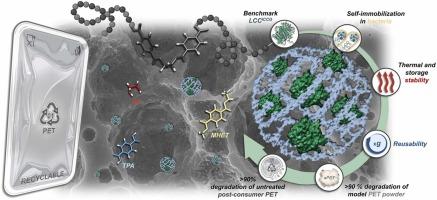几乎完全解聚未经处理的消费后塑料与固定化和可重复使用的PET水解酶
IF 11.3
1区 环境科学与生态学
Q1 ENGINEERING, ENVIRONMENTAL
引用次数: 0
摘要
塑料在环境中的积累已经成为整个社会严重关注的问题。聚对苯二甲酸乙二醇酯(PET)是一种应用最广泛的聚酯塑料之一,近年来,基于酶的生物降解已成为一种有前途的可持续回收策略。然而,将这些技术转化为工业领域面临着几个未被充分探索的挑战,包括生物催化剂的固定化和可重复使用。在这里,我们提出了使用ic标记作为一种新的一步方法,用于蛋白质纳米球中基准pet降解酶LCCICCG的“纤维素”自固定。结果表明,固定化酶对可溶性底物具有活性,并表现出更好的耐热性和长期储存稳定性,在室温下保存3个月后,相对活性仍保持58%。固定化LCCICCG还显示了显著的可重用性,在10个重用周期内活动损失很小。最重要的是,通过去除产物和重复使用酶,在广泛的温度范围(50-70ºC)下,各种未经处理的无定形消费后PET材料几乎完全解聚(>90%)。此外,重复利用导致连续两批消费后PET在6天内几乎完全降解,优于所有在实验室规模上报道的固定化生物催化剂。总的来说,ic标签作为一个有前途的多功能平台出现,用于生产,固定化和再利用高性能PET水解酶,有助于塑料废物的可持续管理。本文章由计算机程序翻译,如有差异,请以英文原文为准。

Nearly complete depolymerization of untreated post-consumer plastic with an immobilized and reusable PET hydrolase
The accumulation of plastics in the environment has become a serious concern for the entire society. In recent years, enzyme-based biodegradation has emerged as a promising and sustainable strategy for the recycling of polyethylene terephthalate (PET), one of the most widely used polyester plastics. However, the translation of these technologies to the industrial field faces several underexplored challenges, including the immobilization and reusability of the biocatalysts. Here, we present the use of IC-Tagging as a novel one-step methodology for the “in cellulo” self-immobilization of the benchmark PET-degrading enzyme LCCICCG in protein nanospheres. The immobilized enzyme showed to be active against soluble substrates and exhibited improved thermal resistance and long-term storage stability, retaining 58 % of relative activity after 3 months at room temperature. Immobilized LCCICCG also demonstrates remarkable reusability, with minor activity loss up to 10 reuse cycles. Most importantly, nearly complete depolymerization (>90 %) of various untreated amorphous post-consumer PET materials was achieved at a wide range of temperatures (50–70 °C) by removing the products and reusing the enzyme repeatedly. Furthermore, reutilization led to almost full degradation of two consecutive batches of post-consumer PET in 6 days, outperforming all immobilized biocatalysts reported at laboratory scale. Overall, IC-Tagging emerges as a promising and versatile platform for the production, immobilization and reutilization of top-performing PET hydrolases, contributing to sustainable management of plastic waste.
求助全文
通过发布文献求助,成功后即可免费获取论文全文。
去求助
来源期刊

Journal of Hazardous Materials
工程技术-工程:环境
CiteScore
25.40
自引率
5.90%
发文量
3059
审稿时长
58 days
期刊介绍:
The Journal of Hazardous Materials serves as a global platform for promoting cutting-edge research in the field of Environmental Science and Engineering. Our publication features a wide range of articles, including full-length research papers, review articles, and perspectives, with the aim of enhancing our understanding of the dangers and risks associated with various materials concerning public health and the environment. It is important to note that the term "environmental contaminants" refers specifically to substances that pose hazardous effects through contamination, while excluding those that do not have such impacts on the environment or human health. Moreover, we emphasize the distinction between wastes and hazardous materials in order to provide further clarity on the scope of the journal. We have a keen interest in exploring specific compounds and microbial agents that have adverse effects on the environment.
 求助内容:
求助内容: 应助结果提醒方式:
应助结果提醒方式:


